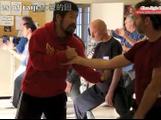This is a part translation of a section from Lin Ketong’s Chinese Blog. Any errors, omission and mistakes are from the mistranslation.
Adhering and Continuously Following; neither Abandoning nor Resisting
粘黏连随不丢不顶
Master Chen said, “To harmonize (合住) means to equalize the force of your opponents. To be accurate you should maintain 49% force against opponents 51% and let the opponent’s force be felt on you. What if he did not manifest his force? Then you have to apply force on the opponent to evoke a counter force from him. Once the force and counter force harmonizes you must not move by maintaining the posture.
If he releases, you still must maintain the 51:49 force ratio. This called not abandoning (丢). If the opponent increases his force, you still maintain the same ratio; this is called not resisting (顶). From the beginning till end harmonizing his force at 51:49% ratio is called adhering, sticking and continuously following. It does not mean just maintaining contact continuously. When you have the harmonizing force at 51:49 you form a relation from the contact point to the opponent’s center. When you control the contact point, you control his center.”



{ 6 comments… read them below or add one }
Is this referred to as “Bu Diu, Bu Ding” in Practical Method?
Yes, “Bu Diu, Bu Ding” is (不丢不顶) ‘neither Abandoning nor Resisting”
(粘黏连随) is ‘Adhering and Continuously Following.”
Thanks! I’d never heard such a detailed explanation of what “Bu Diu, Bu Ding” really means.
Thanks, KS Loke for the translation. 51:49 = 1 whole if both stick/adhere to each other so they’ll move as a whole. But if opponent is 51 and I 49, wudn’t this mean that opponent has 2 more than me and this 2 can be used to reverse back on opponent?
Sorry if I sound naive as I am a TOTAL BEGINNER! Pls clarify.
I think the idea, at least in part, is that you want to harmonize with the opponent to essentially cancel out or neutralize their movements, and be able to use the contacting point to connect to their center so you can destabilize it. At the same time, of course they will be trying to connect to your center so you must be imperceptibly lighter than they are. Being very careful not to misinterpret what lighter means (not soft), better to say 51:49. By maintaining this relationship, because it is such a slight differential, they cannot perceive it, and they think they are connected to your center, but when they attempt to issue, they find that they can’t find anything to attach to. You could say you have a little bit of space (or time) to adjust by maintaining the 51;49 relationship, so you are always connected to their center and they are never connected to yours.
This is more of an attempt to see if I am understanding the concept than to be a definitive answer, so I hope others will clarify.
My understanding is this: we allow the 51 from the opponent is to get her
to commit more and more because she thinks she got you. But you are just playing along until the opportune time. When her resources are committed, you apply an orthogonal force to tip her over her center, making her fall.